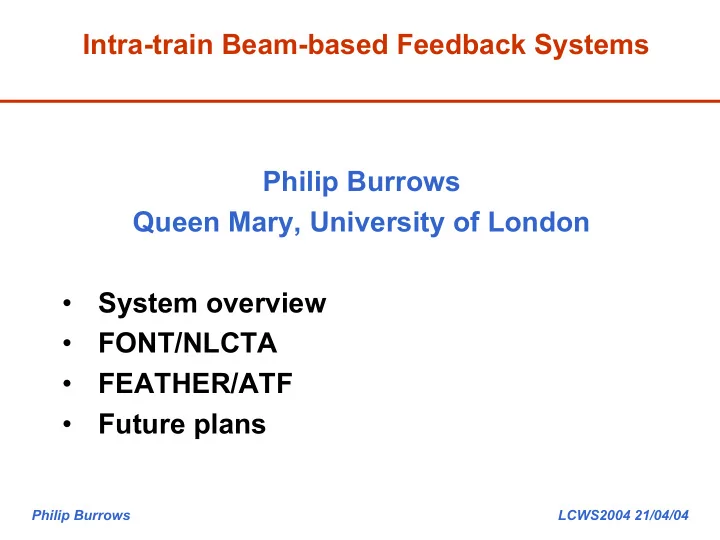

Intra-train Beam-based Feedback Systems Philip Burrows Queen Mary, University of London • System overview • FONT/NLCTA • FEATHER/ATF • Future plans Philip Burrows LCWS2004 21/04/04
International Collaboration • FONT: Queen Mary: Philip Burrows, Glen White, Tony Hartin, Stephen Molloy, Shah Hussain Daresbury Lab: Alexander Kalinine, Roy Barlow, Mike Dufau Oxford: Colin Perry, Gerald Myatt, Simon Jolly, Gavin Nesom SLAC: Joe Frisch, Tom Markiewicz, Marc Ross, Chris Adolphsen, Keith Jobe, Doug McCormick, Janice Nelson, Tonee Smith, Steve Smith, Mark Woodley • FEATHER: KEK: Nicolas Delerue, Toshiaki Tauchi, Hitoshi Hayano Tokyo Met. University: Takayuki Sumiyoshi • Simulations: Nick Walker (DESY), Daniel Schulte (CERN) Philip Burrows LCWS2004 21/04/04
Intra-train Beam-based Feedback Intra-train beam feedback is last line of defence against ground motion Key components: Beam position monitor (BPM) Signal processor Fast driver amplifier E.M. kicker Warm: augments active stabilisation Fast FB circuit Cold: principal ground-motion correction Philip Burrows LCWS2004 21/04/04
Beam Feedback Luminosity Recovery Position scan: Angle scan: G/NLC: recover > 80% of design luminosity TESLA: > 95% feasible Philip Burrows LCWS2004 21/04/04
Feedback on Nanosecond Timescales (FONT) (SLAC/NLCTA) • 100 micron train-train jitter • bunched at X- band (87ps) • 50% Q variation along train: • 170ns long train • 1mm size beam • few 100 micron offsets Philip Burrows LCWS2004 21/04/04
FONT1: results (September 2002) 3kW tube amplifier: 10/1 position correction latency of 67 ns Philip Burrows LCWS2004 21/04/04
FONT1: expected latency • Time of flight kicker – BPM: 14ns • Signal return time BPM – kicker: 18ns Irreducible latency: 32ns • BPM cables + processor: 5ns • Preamplifier: 5ns • Charge normalisation/FB circuit: 11ns • Amplifier: 10ns • Kicker fill time: 2ns Electronics latency: 33ns • Total latency expected: 65ns Philip Burrows LCWS2004 21/04/04
FONT2: outline Goals of improved FONT2 setup: • Additional 2 BPMs: independent position monitoring • Second kicker added: allows solid state amplifiers • Shorter distance between kickers and FB BPM: irreducible latency now c. 16 ns • Improved BPM processor: real-time charge normalisation using log amps (slow) • Expect total latency c. 53 ns: allows 170/53 = 3.2 passes through system • Added ‘beam flattener’ to remove static beam profile • Automated DAQ including digitisers and dipole control Philip Burrows LCWS2004 21/04/04
FONT2: expected latency • Time of flight kicker – BPM: 6ns • Signal return time BPM – kicker: 10ns Irreducible latency: 16ns • BPM processor: 18ns • FB circuit: 4ns • Amplifier: 12ns • Kicker fill time: 3ns Electronics latency: 37ns • Total latency expected: 53ns Philip Burrows LCWS2004 21/04/04
FONT2: beamline configuration Dipole and kickers New BPMs Philip Burrows LCWS2004 21/04/04
FONT2: BPM signal processing Philip Burrows LCWS2004 21/04/04
FONT2: amplifier + beam flattener FB signal into amplifier: Beam flattener: Bandwidth limited (30 MHz) Philip Burrows LCWS2004 21/04/04
FONT2 BPM resolution Residuals: Actual position Resolution 14 microns Predicted position Philip Burrows LCWS2004 21/04/04
FONT2 results: feedback BPM Beam starting positions Beam flattener on Feedback on Delay loop on Philip Burrows LCWS2004 21/04/04
FONT2 results: witness vs. FB BPMs BPM1 (FB) BPM2 (witness) start flatten FB FB + Time (ns) delay Philip Burrows LCWS2004 21/04/04
FONT2 results: gain studies Vary main gain Main gain –ve (!) 0.5 -0.8 0.7 -1.2 0.9 -1.6 1.1 -2.0 1.3 Also: delay loop length + gain … Philip Burrows LCWS2004 21/04/04
FONT2 final results (Jan 22 2004) Super-fast modified configuration: Latency 54ns Correction 14:1 dispersion (limited by gain knob resolution) Philip Burrows LCWS2004 21/04/04
FONT2 Simulation Simulation includes: • time of flight • cable delays • latencies • bandwidths • delay loop Useful tool for LC FB simulations Philip Burrows LCWS2004 21/04/04
Feedback At High Energy Requirements (FEATHER) (KEK/ATF) Philip Burrows LCWS2004 21/04/04
FEATHER: kicker simulations Philip Burrows LCWS2004 21/04/04
FEATHER: kicker perfomance Philip Burrows LCWS2004 21/04/04
FEATHER: latency Philip Burrows LCWS2004 21/04/04
FEATHER: beam scan across kicker gap Philip Burrows LCWS2004 21/04/04
Comparison of NLCTA with ATF NLCTA ATF Train length 170 ns 300 ns Bunch spacing 0.08 ns 2.8 ns Beam size (y) 500 mu 5 mu Jitter (y) 100 mu few mu Beam energy 65 MeV 1.3 GeV Stabilising 1 GeV beam @ 1 mu � 1000 GeV @ 1 nm For the warm machine: ATF has ‘right’ bunch spacing and train length, and the beam is smaller and more stable than at NLCTA -> much better place for fast feedback prototypes Philip Burrows LCWS2004 21/04/04
Future Experimental Programme at ATF FONT and FEATHER are joining forces! 1. Stabilisation of extracted bunchtrain at 1 micron level: low-power (< 100W), high stability amplifier stripline or button BPM w. ~ 1 micron resolution these are exactly what are needed for the LC! 2. Stabilisation of extracted bunchtrain at 100 nm level: requires special (cavity) BPM and signal processing useful as part of nanoBPM project 3. Test of intra-train beam-beam scanning system: high-stability ramped kicker drive amplifier very useful for LC Philip Burrows LCWS2004 21/04/04
Future Experimental Programme at SLAC The SLAC A-line is potentially extremely useful for IP FB system tests: Train charge, length, bunch spacing … parameters can be made relevant for warm or cold machine (Woods) Well instrumented laboratory for BPM tests High-flux e+e- pairs mimic LC IR environment: study impact of pair background on BPM resolution; radiation damage issues for feedback components Philip Burrows LCWS2004 21/04/04
Other issues for intra-train feedbacks • Beam angle-jitter: warm machine: correction best done near IP with RF crab cavity (needed anyway): design + prototyping starting in UK • Ideally, feedback on luminosity: bunch-by-bunch luminosity measurement would allow intra-train luminosity feedback Philip Burrows LCWS2004 21/04/04
Recommend
More recommend